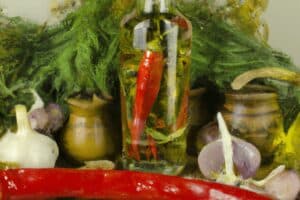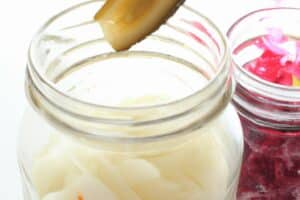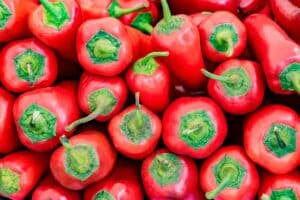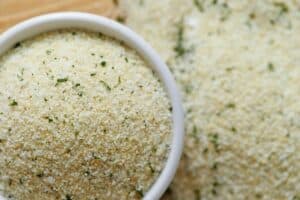From coffee cake to curry, cinnamon is an ingredient used in sweet and savory dishes. But as you’re whipping up a batch of cinnamon apple tarts for your soon-to-arrive guests, you might panic upon shuffling through your spice cabinet and realizing that you used your last teaspoon of cinnamon for eggnog.
Rest easy, for we have five fantastic cinnamon substitutes for you.
Introduction: What is Cinnamon?

Cinnamon is originally from the Ceylon cinnamon tree in South Asia. It thrives in moist and lowland tropical areas. People harvest and dry its inner bark to use for cooking and medicinal purposes. You can purchase cinnamon in bark form, as a powder, and as oil.
Researchers praise cinnamon for its health benefits. It’s an antioxidant, helps reduce inflammation, prevents cancer, and may prevent neurological diseases like Parkinson’s and Alzheimer’s.
So, if you don’t have time to go to the store to purchase another jar of cinnamon, these cinnamon substitutes will help your recipe stay on track.
Top 5 Substitutes For Cinnamon
1. Allspice
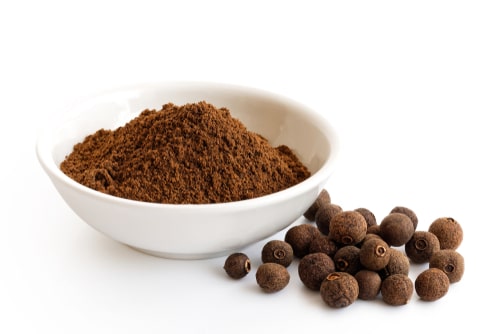
Allspice is one of the best cinnamon replacements because it closely resembles the flavor of cinnamon and many people already have it in their cupboards. Allspice also has a similar texture to cinnamon in its ground state. Like cinnamon, you can use allspice whole, but it’ll be in the form of small, dried berries instead of long bark pieces.
Strong, earthy tones are hallmarks of allspice. As with cinnamon, it has a slightly sweet flavor. Allspice originates from the Pimenta dioica evergreen tree in the West Indies, and many people comment that its taste is similar to a combination of cinnamon, cloves, nutmeg, and pepper.
It’s easy to go overboard when tossing ingredients together, but when using allspice to replace cinnamon in your recipe, you’ll want to use about one-third of the amount. Your best bet is to start with a modest amount of allspice and taste test your way as you add more until you’re satisfied with its cinnamon flavor.
If your supermarket is out of cinnamon and you purchase allspice as a substitute, know that there are many recipes you can use the remaining bottle with. In addition to any recipe using cinnamon, you can use your extra allspice in marinades, soups, sausages, and pureed root vegetables.
As you “wow” your guests with your ingenious cinnamon alternative, you can share some fun facts about allspice with them. For example, when the British arrived in the Americas, they didn’t know what to make of allspice because of its multi-layer taste, so they named it “all spice.”
2. Pumpkin Spice
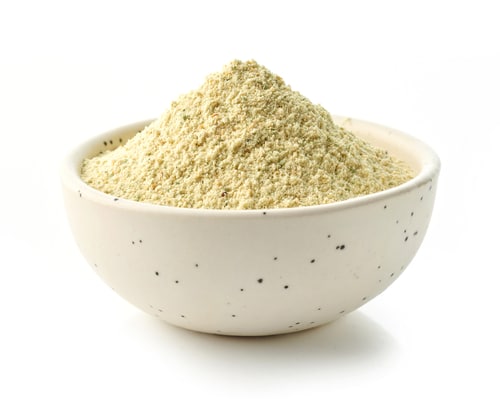
What better substitute for cinnamon than using an ingredient that already contains it? Pumpkin spice is a mix of several delicious spices, many of which are cinnamon alternatives. Although pumpkin spice may feel like a modern-day invention with so many foods and drinks containing it during autumn, pumpkin spice originates in Mongolia and is hundreds of years old.
It won’t take you long to realize why pumpkin spice is such a great substitute for cinnamon. The most notable ingredients in this mixture include:
- Cinnamon
- Vanilla
- Cloves
- Nutmeg
- Mace
- Allspice
- Cardamon
Unlike allspice, pumpkin spice doesn’t have an extra-strong flavor. Therefore, it should be okay to use pumpkin spice in the same ratio that your cinnamon recipe states. For example, if your recipe calls for a ½ teaspoon of cinnamon, you should be able to use a ½ teaspoon of pumpkin spice. Don’t be surprised if you end up liking your recipe more with the pumpkin spice—it has such a rich combination of flavors that it just may add an extra pop to your dish!
Here’s an extra tip for you—you can use apple spice instead of pumpkin spice. Apple spice has nearly the same ingredients, just in a different ratio. Alternatively, if there are slim pickings in your cabinet or grocery store, look through your spices and see if you have any other spice mixtures that contain some of the ingredients listed above.
3. Nutmeg and Cloves
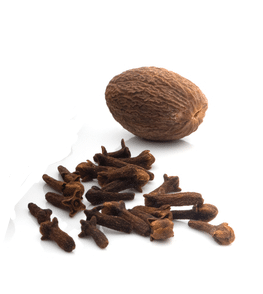
Nutmeg and cloves are two ingredients that can serve as a cinnamon substitute either together or separately, depending on the contents of your spice rack. Let’s look at each individually and then see how they combine to form a cinnamon-like flavor.
Despite its name, nutmeg is a seed, not a nut. The seed originates from an evergreen tree in Indonesia. You can consume it in a dry, powder state (which is ideal for cinnamon substitution), as an essential oil, and nutmeg butter. Nutmeg has antibacterial properties and is a source of antioxidants to fight illnesses like heart disease and cancer. It can also produce psychoactive effects, but you’d have to consume a massive amount for that to happen.
Cloves also come from a tropical evergreen tree. To produce cloves for consumption, farmers harvest and dry the tree’s unopened flower buds. You can purchase cloves in a ground form (which you’ll want for your recipe) and as an essential oil. Cloves have a powerful aroma and pungent taste, so you’ll want to use them in moderation. As an antiseptic and analgesic, they offer many health benefits.
When using nutmeg and cloves as a cinnamon substitute, it’s important to gradually add one or both of these ingredients to avoid overpowering your dish. Both have a strong flavor, and they’re not quite as equal of a flavor substitute as allspice and pumpkin spice.
We recommend starting with a quarter of the amount your recipe calls for and adding more from there if needed. Keep in mind that if you’re using both nutmeg and cloves, you’ll need to divide the amount in half, making for one-eight each of the original amount.
4. Cardamom
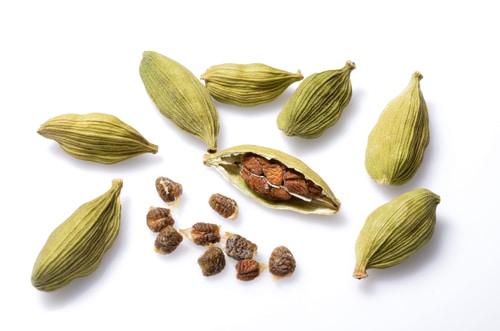
Perhaps unsurprisingly, cardamom also originates in South Asia. Using cardamom as a cinnamon replacement is a solid option if your kitchen cabinets and stores don’t have the ingredients we discussed. There are two kinds of cardamom—green and black—and both come as seeds in a small pod.
We know that your options might be limited, but if you happen to have both green and black cardamom in your house, choose the green kind as your cinnamon substitute. The reason is that green cardamom has a powerful spicy flavor. Black cardamom also has a strong flavor, but it ranges somewhere between a smokey taste and cool mint.
Generally speaking, cardamom is a better cinnamon alternative when making savory dishes instead of sweet dishes. That’s due in part to how strong its aroma is. Although cinnamon substitutes are what we’re going for here, there’s no match for the real spice. Therefore, when making savory dishes, you can add cardamom to offer a cinnamon-like flare while knowing that other ingredients in your dish should help to balance out its strong flavor.
Despite its powerful taste, often people use the same ratio of cardamom as cinnamon in their recipes. That means that if you needed to use one teaspoon of cinnamon, you should be able to use one teaspoon of cardamom. Nevertheless, it’s best to start slowly and taste as you add in more spice.
Whether you use cardamom as a cinnamon substitute or in other dishes, consistent consumption can have positive effects on your health. Cardamon wards off infections, improves heart health, reduces sciatica symptoms, and offers cognition-enhancing benefits such as better memory function.
5. Cinnamon Extract
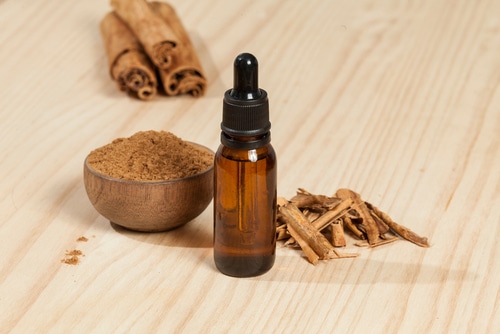
It may seem like we should have included an ingredient containing cinnamon towards the top of this list, but since it comes in liquid form and can cause allergies, cinnamon extract isn’t always suitable for recipes.
Companies make cinnamon extract in a similar way that they make vanilla extract—by soaking cinnamon bark in alcohol and disposing of its solids. As a result, cinnamon extract has a stronger flavor than ground cinnamon. That said, cinnamon extract has a less potent taste than cinnamon oil, which they remove directly from the bark. For that reason, when seeking a cinnamon replacement, it’s best to use cinnamon extract instead of cinnamon oil.
When consumed in high doses, some people may feel the effects of cinnamon’s toxic compound, coumarin. For this reason, using cinnamon extract as a substitute for ground cinnamon isn’t a good choice for people prone to food allergies.
If you have a bottle of cinnamon extract, you can pour a few drops at a time into your recipe until you’re happy with its taste. Alternatively, if you have cinnamon sticks and rum at home, you can make your own cinnamon extract by letting two pieces of bark soak in ¼ cup of rum for a couple of weeks.
Aim to get a lot of use out of it after making cinnamon extract; unlike ground cinnamon, cinnamon extract has a shorter shelf life.
Conclusion
With so many options to choose from, if you get in a cinnamon pinch, you can easily “pinch” in one of the alternative spices we discussed here. Many of these cinnamon substitutes are so similar to cinnamon that you just may forget your recipe doesn’t have cinnamon in it!


